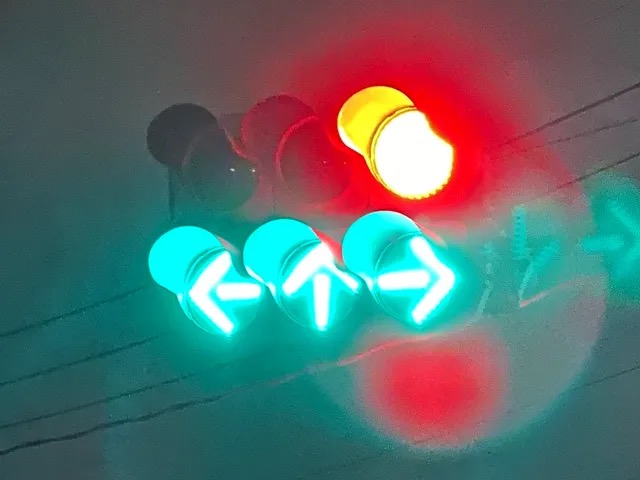
If you’re driving in Japan, don’t be caught out by seeing red and green signals together.
A lot of road traffic rules are pretty straightforward in Japan, but one situation that could make you freeze for a moment is when you come across a traffic light at an intersection that has a big red stoplight on it, but green arrows in all directions underneath.
▼ When you approach a red light while driving, your first instinct is to hit the brakes, so what are you meant to do at this intersection?
Well, in a nutshell, this is a sign to proceed through the intersection in all directions that are green.
▼ So why not just use a green light, and what’s the purpose of the red?
The reason why the red light is shown is because it signals that oncoming traffic is currently stopped at a red light. Unlike regular traffic lights, which simply display green to drivers and pedestrians travelling in both directions along the same stretch of road, these special traffic lights run on a differentiated system, whereby one lot of traffic is given right of way for set periods.
These types of lights are generally installed to prevent congestion at intersections where there are more right-turning vehicles than usual. This system assists these drivers by ensuring that oncoming traffic has stopped and pedestrian signals are red, therefore making it safe to proceed with right turns without having to slow down as much as they would otherwise.
▼ At this moment, all pedestrian signs at the intersection are red and the lights for traffic heading across the intersection from left, right, and straight ahead are red as well.
As long as the light above the green arrows remains red, the light for everyone else crossing the intersection remains red. So when their lights change, these lights do too, making things potentially more confusing for first-timers.
As the lights are generally aimed at drivers turning right, the amber light in the sequence above lets these drivers know that oncoming traffic is about to stop. When it hits red, the right arrow turns green, giving them the go-ahead to turn right.
So how do you know when to stop at these traffic lights? Well, all lights will switch off and the amber light will be shown, followed by…
▼…the red stoplight on its own.
The solitary red light is the signal for traffic to stop, until the green directional arrows appear again. Whenever these green arrows are visible, it’s safe to proceed in the directions shown, regardless of whether or not there’s a red light next to them, although it’s important to remain cautious in case pedestrians and cars don’t abide by the signals.
So what might initially be a confusing, head-scratcher of a system is actually a pretty ingenious one designed to keep things running smoothly while safeguarding drivers and pedestrians. It’s one of many interesting things to learn about on the roads, once you’ve gone through the rigmarole of acquiring a Japanese driver’s license!
Photos © SoraNews24
● Want to hear about SoraNews24’s latest articles as soon as they’re published? Follow us on Facebook and Twitter!
[ Read in Japanese ]

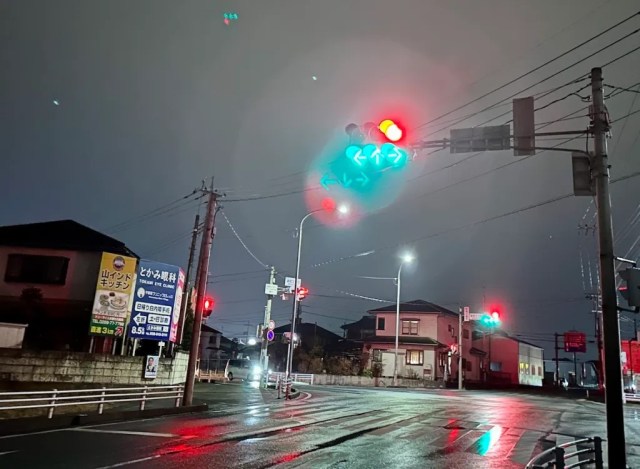
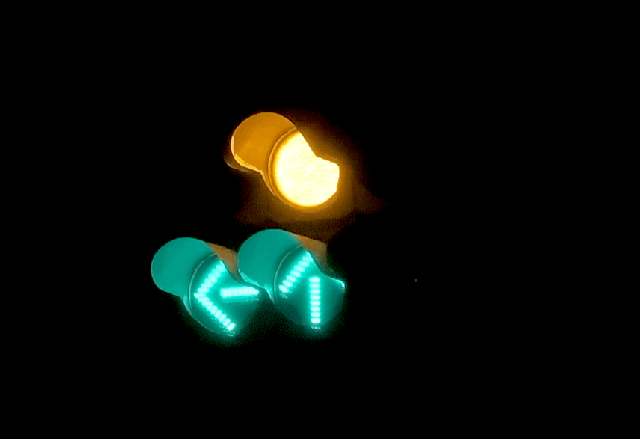
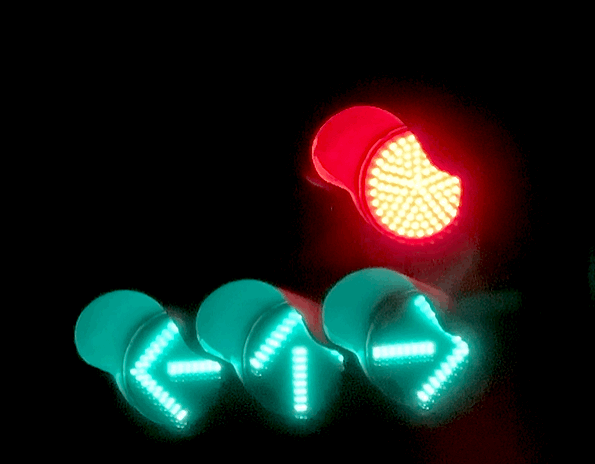
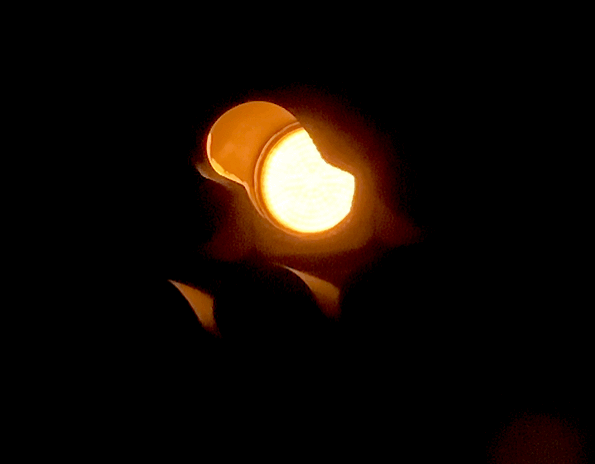
 People wowed by Japanese road signs that change automatically in seconds 【Videos】
People wowed by Japanese road signs that change automatically in seconds 【Videos】 Frightening video shows car speeding through Tokyo’s Scramble Intersection filled with people
Frightening video shows car speeding through Tokyo’s Scramble Intersection filled with people Japan’s National Police Agency plans to introduce fines for bike traffic violations in 2026
Japan’s National Police Agency plans to introduce fines for bike traffic violations in 2026 Harrowing video sees reckless drivers ignore pedestrian crossing in Japan【Video】
Harrowing video sees reckless drivers ignore pedestrian crossing in Japan【Video】 Aichi Police refund over a million yen in fines to drivers who violated a misplaced traffic sign
Aichi Police refund over a million yen in fines to drivers who violated a misplaced traffic sign Seaside scenery, history, and so many desserts on Yokohama’s Akai Kutsu【Japan Loop Buses】
Seaside scenery, history, and so many desserts on Yokohama’s Akai Kutsu【Japan Loop Buses】 Japan’s summertime towelket pillowcases are even better with the addition of Ghibli stars【Photos】
Japan’s summertime towelket pillowcases are even better with the addition of Ghibli stars【Photos】 Foreigner’s request for help in Tokyo makes us sad for the state of society
Foreigner’s request for help in Tokyo makes us sad for the state of society Japanese city loses residents’ personal data, which was on paper being transported on a windy day
Japanese city loses residents’ personal data, which was on paper being transported on a windy day Do Hi-Chew-flavor Hi-Chews have a reason to exist?【Taste test】
Do Hi-Chew-flavor Hi-Chews have a reason to exist?【Taste test】 Haku is…Chihiro’s dead brother? Studio Ghibli fans blown away by Spirited Away theory
Haku is…Chihiro’s dead brother? Studio Ghibli fans blown away by Spirited Away theory Harajuku Station’s beautiful old wooden building is set to return, with a new complex around it
Harajuku Station’s beautiful old wooden building is set to return, with a new complex around it Should you add tartar sauce to Japanese curry rice? CoCo Ichi makes diners an unusual offer
Should you add tartar sauce to Japanese curry rice? CoCo Ichi makes diners an unusual offer Restaurant Yoshibei is crazy in the best way: A pork cutlet set with a side of pork cutlet bowl
Restaurant Yoshibei is crazy in the best way: A pork cutlet set with a side of pork cutlet bowl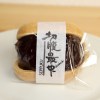 Suicide cakes – Sweets to die for
Suicide cakes – Sweets to die for McDonald’s new Happy Meals offer up cute and practical Sanrio lifestyle goods
McDonald’s new Happy Meals offer up cute and practical Sanrio lifestyle goods Japanese ramen restaurants under pressure from new yen banknotes
Japanese ramen restaurants under pressure from new yen banknotes French Fries Bread in Tokyo’s Shibuya becomes a hit on social media
French Fries Bread in Tokyo’s Shibuya becomes a hit on social media Studio Ghibli releases new action figures featuring Nausicaä of the Valley of the Wind characters
Studio Ghibli releases new action figures featuring Nausicaä of the Valley of the Wind characters Red light district sushi restaurant in Tokyo shows us just how wrong we were about it
Red light district sushi restaurant in Tokyo shows us just how wrong we were about it New private rooms on Tokaido Shinkansen change the way we travel from Tokyo to Kyoto
New private rooms on Tokaido Shinkansen change the way we travel from Tokyo to Kyoto Tokyo Tsukiji fish market site to be redeveloped with 50,000-seat stadium, hotel, shopping center
Tokyo Tsukiji fish market site to be redeveloped with 50,000-seat stadium, hotel, shopping center Beautiful Ghibli sealing wax kits let you create accessories and elegant letter decorations【Pics】
Beautiful Ghibli sealing wax kits let you create accessories and elegant letter decorations【Pics】 Studio Ghibli releases Kiki’s Delivery Service chocolate cake pouches in Japan
Studio Ghibli releases Kiki’s Delivery Service chocolate cake pouches in Japan New definition of “Japanese whiskey” goes into effect to prevent fakes from fooling overseas buyers
New definition of “Japanese whiskey” goes into effect to prevent fakes from fooling overseas buyers Our Japanese reporter visits Costco in the U.S., finds super American and very Japanese things
Our Japanese reporter visits Costco in the U.S., finds super American and very Japanese things All-you-can-drink Starbucks and amazing views part of Tokyo’s new 170 meter-high sky lounge
All-you-can-drink Starbucks and amazing views part of Tokyo’s new 170 meter-high sky lounge More foreign tourists than ever before in history visited Japan last month
More foreign tourists than ever before in history visited Japan last month New Pokémon cakes let you eat your way through Pikachu and all the Eevee evolutions
New Pokémon cakes let you eat your way through Pikachu and all the Eevee evolutions Disney princesses get official manga makeovers for Manga Princess Cafe opening in Tokyo
Disney princesses get official manga makeovers for Manga Princess Cafe opening in Tokyo Sales of Japan’s most convenient train ticket/shopping payment cards suspended indefinitely
Sales of Japan’s most convenient train ticket/shopping payment cards suspended indefinitely Sold-out Studio Ghibli desktop humidifiers are back so Totoro can help you through the dry season
Sold-out Studio Ghibli desktop humidifiers are back so Totoro can help you through the dry season Japanese government to make first change to romanization spelling rules since the 1950s
Japanese government to make first change to romanization spelling rules since the 1950s Ghibli founders Toshio Suzuki and Hayao Miyazaki contribute to Japanese whisky Totoro label design
Ghibli founders Toshio Suzuki and Hayao Miyazaki contribute to Japanese whisky Totoro label design Doraemon found buried at sea as scene from 1993 anime becomes real life【Photos】
Doraemon found buried at sea as scene from 1993 anime becomes real life【Photos】 Tokyo’s most famous Starbucks is closed
Tokyo’s most famous Starbucks is closed One Piece characters’ nationalities revealed, but fans have mixed opinions
One Piece characters’ nationalities revealed, but fans have mixed opinions We asked a Uniqlo employee what four things we should buy and their suggestions didn’t disappoint
We asked a Uniqlo employee what four things we should buy and their suggestions didn’t disappoint Princesses, fruits, and blacksmiths: Study reveals the 30 most unusual family names in Japan
Princesses, fruits, and blacksmiths: Study reveals the 30 most unusual family names in Japan Japanese survey finds only 23 percent of vehicles stop for pedestrians at crosswalks
Japanese survey finds only 23 percent of vehicles stop for pedestrians at crosswalks Japanese police officer pursues, pulls over Lamborghini supercar…while on a bicycle【Video】
Japanese police officer pursues, pulls over Lamborghini supercar…while on a bicycle【Video】 Driver who killed cyclist in crosswalk accident found not guilty, causes controversy in Japan
Driver who killed cyclist in crosswalk accident found not guilty, causes controversy in Japan Simulation shows the chaotic consequences of walking in Shibuya while staring at your phone
Simulation shows the chaotic consequences of walking in Shibuya while staring at your phone These “star marks” on the road in Japan that indicate when to use your blinker are amazing【Video】
These “star marks” on the road in Japan that indicate when to use your blinker are amazing【Video】 Tokyo Police Join Forces With Final Fantasy to End Traffic Accidents
Tokyo Police Join Forces With Final Fantasy to End Traffic Accidents Man attempts to set himself on fire in middle of Tokyo’s busiest intersection【Video】
Man attempts to set himself on fire in middle of Tokyo’s busiest intersection【Video】 Japanese custom of bowing to cars at crosswalks keeps locals safe, warms Internet’s hearts【Video】
Japanese custom of bowing to cars at crosswalks keeps locals safe, warms Internet’s hearts【Video】 “Conbini warp” an increasing traffic problem for businesses and authorities across Japan
“Conbini warp” an increasing traffic problem for businesses and authorities across Japan Tokyo’s biggest street party spot bans public drinking on New Year’s Eve
Tokyo’s biggest street party spot bans public drinking on New Year’s Eve Japanese youths anger police by sitting at kotatsu table at busy Kyoto intersection【Video】
Japanese youths anger police by sitting at kotatsu table at busy Kyoto intersection【Video】 Possibly the most considerate pedestrian crossing button ever installed
Possibly the most considerate pedestrian crossing button ever installed Japanese YouTuber sleeps on a bed in the middle of Shibuya Scramble Crossing【Video】
Japanese YouTuber sleeps on a bed in the middle of Shibuya Scramble Crossing【Video】 Traffic camera in China captures brutality of woman’s accident, humanity of her rescuers
Traffic camera in China captures brutality of woman’s accident, humanity of her rescuers
Leave a Reply